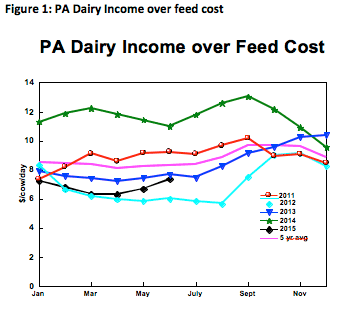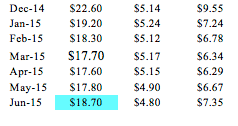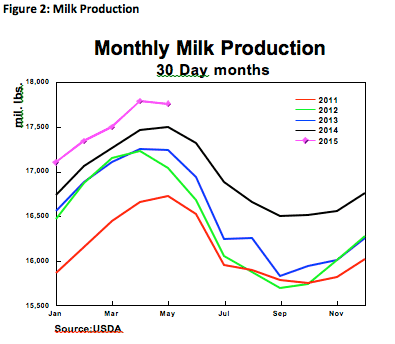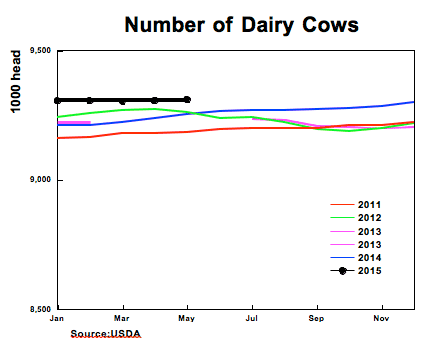

Market Psychology
The problems in Greece and its debt owed to the European Union have sent world markets in a tizzy. The value of the dollar rose against the currencies of other dairy exporters, as the challenges in Europe are added to the continuing weakness in China and other parts of East Asia. The strength in the dollar will hurt exports of everything that the USA exports. The continued bad weather in the Corn Belt has lowered expectations about the corn and soybean crops, sending them up despite worse export opportunities. The prices of the exportable dairy products all have fallen in the past month, with cheese down by 3.2%, butter by 1.5%, skim milk powder by 6%, and dry whey by 2.3%.
The Australian dollar is down 3.7% and the New Zealand dollar down by 6.6%. The Euro has fallen 1.9%. The events in Greece are changing daily, but no resolution seems imminent, and only an outright forgiveness of enormous debt will give them a chance to escape this burden. The structural problems with the Greek economy will never generate enough cash to even service the debt, let alone reduce meaningfully it.
Table 1 lists some past and estimated future milk prices. I estimate the June Pennsylvania all-milk price to be $18.70/cwt, up $0.90 from May. The dairy futures market prices for Class III and IV show higher prices in the rest of 2015, although lower than the market expected a month ago. The average Class III price for the first six months was $15.99/cwt. and the futures for the last six months of 2015 average $16.40. The June Class IV price was down $0.01/cwt. from May at
$13.90/cwt. The Class IV futures prices are higher than the $13.70 for January through June, averaging $14.02 for the next 6 months. This is down considerably from last month, as export prospects seem dimmer and milk production continues to increase. My forecast for the average Pennsylvania all-milk price for 2015 is
$18.40/cwt., which is $7.24/cwt. below 2014.

The strong U.S. dollar continues to challenge U.S. exporters of dairy products. Dairy exports in April were 75% of their amounts in April 2014, despite much lower prices, and of course causing much lower prices. Prices in the Global Dairy Trade auctions in New Zealand continue to fall. Russia has been hit with additional sanctions by the European Union, meaning the expanding milk production after the end of EU quotas will end up on world markets.
Corn and Soybean Markets
Corn and soybean markets have risen sharply, as bad weather in the Midwest (too much rain) has impaired planting and flooded fields already planted. Ordinarily a surplus of moisture is not an issue in these states, but this year is not typical. The Corn Belt has excessive moisture from Ohio west to Missouri and some areas west of that are also excessively moist. Smaller corn and soybean crops are now expected, which will reduce the massive ending stocks after the 2015 harvest.
While feed prices have risen, they will not be especially high, but the falling milk prices, higher feed prices, and, especially important, perhaps less home-produced feed due to the difficulty harvesting hay, are a bad combination.
Income over Feed Costs (IOFC)
Penn State's measure of income over feed costs rose by 10% in June, as milk prices rose and feed prices fell. Figure 1 shows how these values compare to recent years. June's feed cost is 10¢/cow/day less than in May. June's value for IOFC of $7.35/cow/day is well below the 2014 value, when the milk price was very high and feed prices were somewhat higher. The improvement in the milk price is the driver of the higher IOFC than last month. Income over feed cost reflects daily gross milk income less feed costs for an average cow producing 65 pounds of milk per day. Table 2 and Figure 1 showing the monthly data follow.
The allocation of the revenue per hundred pounds of milk (milk margin) is shown in Table 3. The milk margin is the estimated amount of the Pennsylvania all milk price that remains after feed costs per hundredweight of milk production are paid. Like income over feed cost, this measure shows that the June PA milk margin was 10% higher than in May.



Milk Production
The latest milk production report showed May milk production up 1.5% from a year earlier, a smaller increase than last month (Figure 2). This increase in milk production matches the percentage increase of May of last year, although it is a decrease from April's milk production. Of greater importance, is that on a 30 day month basis, milk production in May was below April, which is somewhat unusual and an indication that the impact of the California drought and low milk prices are causing a supply response. Given the lagging export markets and the production problems in California with its drought, this is an appropriate response to conditions. The monthly cow numbers are shown in Figure 3. The May cow numbers rose by only 0.63%. This growth is minimal, although some states have been increasing herd size, especially Michigan and Idaho among the leading dairy states. Year over year cow number increases continue to be a source of milk production growth, despite the falling milk production in California. The growth in cow numbers last year was much greater than this year. Of course, the incentives were greater as well.




By Jim Dunn, Professor of Agricultural Economics
Penn State University
7.8.2015